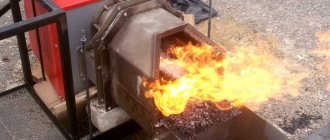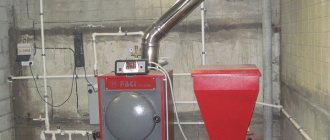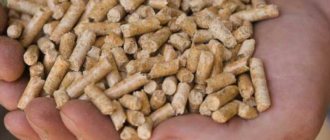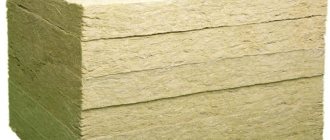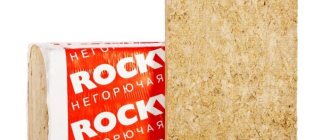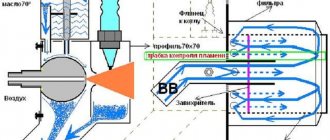0
3459
21.12.2015
From this article you will learn everything about pellets: production rules, standards and methods of quality control. To ensure stable operation of pellet heating boilers, which are often installed in autonomously operating boiler rooms, the “correct” pellets are needed. This English word refers to small fuel pellets that are made by pressing wood flour. The raw materials for this fuel are very simple. It can be sanded or unsanded wood, waste from sawmills, large or small woodworking enterprises and furniture production.
Manufacturers of this alternative solid fuel have even mastered the production of agropellets from ordinary straw, sunflower husks, corn, buckwheat husks, etc. When transporting pellets and storing them, you must comply with a number of requirements that are much softer than the rules that apply to liquid and gaseous fuels. Therefore, the popularity of solid fuel heating boilers using pellets is growing noticeably among owners of individual suburban housing. When purchasing such granulated fuel, all consumers are interested in its properties and quality, since the performance of all boiler equipment and the percentage of efficiency directly depend on this. The main influence on the quality of pellets is provided by raw materials, organization of the production cycle, storage conditions of the final product and its delivery to the consumer.
Technical requirements for pellets:
| Indicator name | Actual | Compliant |
| Total moisture on working base | 6,89% | ISO 589, DIN 52183 |
| Ash on a dry base | 0,58% | ISO 1171, DIN 51719 |
| Ash on a dry base | 0,54% | |
| Volatile substances on a dry base | 84,33% | ISO 562, DIN 51720 |
| Volatile substances on the working base | 78,52% | |
| Calorific value on dry basis | 4874 Kcal/kg | ISO 1928, DIN 51900 |
| Calorific value per working basis | 4538 Kcal/kg | ISO 1928, DIN 51900 |
| Working calorific value per working basis | 4205 Kcal/kg | ISO 1928, DIN 51900 |
| Sulfur on a dry base | less than 0.01% | ISO 19579, DIN 51724 |
| Sulfur as a working base | less than 0.01% | |
| Hydrogen on dry basis | 6,44% | ISO 12902, DIN CEN/TS 1510 |
| Hydrogen on a working basis | 6,00% | |
| Strength | 97,2% | EN 15210-1 |
| Abrasion | 2,8% | |
| Dust content | +3.15 mm: 98.4% -3.15 mm: 1.6% | CEN/TS 15149-1 |
Classification by variety
“light” (best grade)
“gray” (medium quality)
“dark” (lower quality)
What is the density
- Bulk density;
- The density of the pellet itself.
Typically, it is the bulk specific gravity that is taken into account everywhere and in all standards. If you want to calculate it yourself, then you will not have any problems, for this you will need:
- Scales accurate to tenths of grams;
- Calipers;
- Liter capacity;
- Calculator.
I would also like to talk about standards, in Russia we do not have them, we are guided by the single European standard ENPLUS. I even have a book about obtaining this standard. If you are interested in it, you can read more about obtaining it in the “MY BOOKS” section.
Bulk density
Many people ask why this parameter needs to be measured for wood pellets at all? Who cares? Well, it burns in the boiler, what is it, what is it?
The point here is that the bulk specific gravity reflects the quality of the pellet, and to be precise, its strength. Look, there is a standard big bag for transporting pellets. It should contain exactly 900 kilograms of granules. There are so many high-quality pellets, but if their quality decreases, for example, they are not pressed or the raw materials have high humidity. Then the bag will no longer contain 900 kilograms, but eight hundred and fifty.
Even without conducting any experiments on the bag, it is clear that something is wrong with the pellets. They begin to come out and do not fit into the bag when packing.
Such pellets will have a lower calorific value, occupy a larger volume of space during storage, and can heat up and even spontaneously ignite.
Therefore, when taking a large batch of granules, you must check their specific gravity. Normally it should be 640 - 670 kg/m3.
To determine this parameter, you need to collect one liter of pellets and weigh it. Its normal weight, excluding capacity, will be 640-670 grams.
Granule Density
This parameter is the average specific gravity of the granule itself in the batch.
It is defined as:
- Pav = (P1+P2+P3+P4+P5)/5
- P1-5=mass/volume (kg/m3);
The mass of one pellet can be determined on a scale with an accuracy of tenths of a gram; for example, our mass will be equal to 3.2 grams;
The volume of the pellet can be determined as follows: take and measure the diameter and length with a caliper, then calculate using the following formula:
- V=3.14*R*R*H,
- where 3.14 is the PI number;
- R is the radius of the pellet, for this we divide the diameter of the granule in half, in mm;
- H is the height of the pellet in mm.
When measuring, it is necessary that all ends of the pellet are even.
Pellet quality
For the consumer, quality is always important, and also that the price matches it. Due to the deteriorating environmental situation in the world, many manufacturers who use fuel in their work are looking for an alternative source of energy. Coal, oil, and gas are gradually fading into the background, because their use is harmful to the environment and sometimes to human health. That is why fuel pellets will soon occupy the highest position in the ranking.
The quality of pellets can be fully determined after combustion. It will be possible to see the amount of ash remaining after use. Ash content shows the ratio of the mass of ash to the mass of burned fuel material. If it is 0.5% of the total burned volume or less, then the fuel is of high quality. Why is low ash content important? This is due to the fact that boilers in which fuel is burned can quickly fail due to the abundance of residues in the form of sand, earth and ash. Also, if the ash content is too high, then the boilers must be cleaned very often to avoid equipment breakdown. If you use high-quality pellets, then it is possible to automate the supply of fuel to the boiler, and you can clean it much less often. The remaining 0.5% of the ash can be used as fertilizer for garden plants and poor soil.
If you have the opportunity to look at the fuel before purchasing, then pay attention to their appearance. Let's look at some points that will help you determine the quality of pellets by visual signs. If you hold the granule up to the light, it should be glossy and sparkle, and there should be no cracks or chips on it. When pressed, if the pellet crumbles, then it is of poor quality. It should withstand slight pressure and remain in its original shape. We recommend that you analyze the prices of several manufacturers before purchasing a large batch. This is necessary in order to understand the average price of the product. If one seller has a too low price compared to others, then you should understand that the quality may be questionable. Low-quality pellets are consumed much more than high-quality ones, all because they have low hardness and heat transfer. It is possible that the use of cheap fuel can lead to the failure of the pellet boiler.
"Wood Technologies" is engaged in the production of alternative, environmentally friendly fuel. To ensure the quality of the pellets, you can receive a free sample for testing. You will be able to inspect the products visually and watch them in action. For any questions, call: +7 (831) 339-14-60 or request a call back from the website.
Pellet consumption
When designing a heating system in a private home, the issue of choosing a power source is acute. Of course, the gas boiler remains the easiest to maintain and the most economical in our country. But such systems are not safe. In addition, if you live in a remote, ungasified region, and the main gas pipeline runs very far from home, there is no way to extend it, there are not many options left:
- electrical appliances (warm floors, electric boilers, infrared heaters, etc.);
- solar collectors;
- solid fuel.
The use of electrical appliances is irrational in terms of heating costs. Not everything is clear with solar collectors either. What remains is solid fuel: coal, firewood, briquettes, pellets.
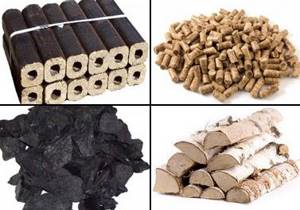
Solid fuel
Which of these fuels should you prefer? And there is no clear answer here. If we talk about ease of use, then the best choice is pellets, which allow you to automate the heating process. But this also leads to a minus: you need to purchase a pellet boiler (which is not cheap). It has a hopper for filling pellets: from the hopper, using an auger, pellets are fed into the firebox.

Fuel boiler
Both pellets and briquettes have minimal humidity, which makes them 1.5–2 times more economical than conventional firewood. Pellets have almost the same consumption as coal. But at the same time, pellets for the boiler (white, premium grade) have low ash content.
Features of heating with pellets
In order to use pellets as fuel more efficiently, you need to purchase a special boiler. Pellet boilers operate in an automated mode: fuel pellets are stored in special containers - pellet bunkers, from which they are fed into the boiler using an auger.
If you want to save money and buy gray rather than white pellets, we advise you not to buy a large batch of fuel at once: not all burners can handle them. First, buy a bag and test it. If the boiler is working normally, you can purchase a larger batch. Do the same with agropellets: first test the operation of the boiler with a small amount. But besides the ash content, there may be other problems: these granules do not tolerate transportation well, so already at this stage you will end up with a lot of waste. So it turns out that heating with this fuel, even if the boiler can handle it, is advisable if the production is somewhere nearby.
The ideal pellets for boilers are white. Their composition is usually homogeneous, and the ash content is low. Due to the characteristics of the raw material, the surface of such granules is dense, they crack and crumble less, and withstand transportation better.
Pellet production
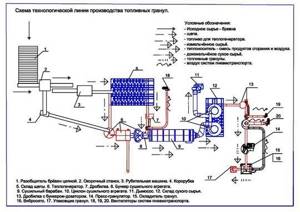
Pellet production scheme
The technology for the production of fuel pellets, as well as fuel briquettes, is based on the process of pressing crushed waste wood, straw, husks, etc.
Raw materials (sawdust, straw, etc.) enter the crusher, where they are crushed into flour. The resulting mass enters the dryer, from which it goes into a granulator press, where wood flour is pressed into granules. Compression during pressing increases the temperature of the material, the lignin contained in the wood softens and glues the particles into dense cylinders.
The production of one ton of pellets requires 3-5 m3 of wood waste with natural moisture. The finished granules are cooled and packaged in large big bags (several tons each) or small packages from several kilograms to several tens of kilograms.
Wood pellet production technology
The arrangement of equipment at each enterprise may be different. However, the principles have been common since the inception of pellet production technology in 1947. The granulation process itself - pelletization occurs in special ring stamps (molds) with rotating rotary rollers, which are pressed into numerous holes - mold dies, crushed wood raw materials activated by steam, after which, granules cut from the outside of the stamp with a special knife, must be cooled and separated from fine particles.
The entire production process can be divided into several stages:
- Grinding;
- Drying;
- Regrinding;
- Water treatment;
- Pressing;
- Cooling;
- Packing and packing;
Grinding of wood raw materials
Chipper machines (Crushers) crush wood raw materials to a fraction with dimensions of no more than 25x25x2 mm for further drying. To reduce energy costs for drying, it is best to grind it to a finer fraction.
Drying
Wood raw materials must have a moisture content of 10% ± 2% before pressing. Raw materials with more or less moisture require additional moisture or additional drying. Dryers
are divided into two types:
- drum;
- tape (more expensive, but safer).
Based on the type of drying agent used, they are divided into dryers:
- on flue gases;
- hot air;
- water vapor;
By type of fuel used for pellet production:
- gas;
- on wood waste.
Regrinding of dry raw materials
For stable operation of the press, the input fraction should be no more than 4 mm. This fraction can be provided by a hammer mill, flaker or disintegrator.
Water treatment
Raw materials with a moisture content of less than 8% are difficult to press, so a device for additional moistening of the raw materials is required. The best option is screw mixers with the ability to supply water or steam. Steam is used to reduce the strength and increase the plasticity of hardwood raw materials. Due to their design features, presses from some manufacturers do not require the addition of steam. Some people use steam for old, caked raw materials, but with such raw materials it is difficult to obtain good quality granules.
Pressing
At the heart of the entire granulation process is the press. Today there are several dozen press manufacturers from around the world:
- CPM;
- Andritz;
- Salmatec;
- Amandus Kahl;
- Buhler;
- Munch;
1
– press with a round matrix;
2
– flat die press
Many presses differ in design by type of matrices
:
- round die press;
- flat die press.
Round die press
developed for the feed, food and chemical industries.
A press with a flat matrix
was originally designed for recycling industrial and household solid waste.
Today, presses of both modifications used in granulation work on the same principle. Running rollers create a contact stress of crushing the raw materials on the matrix, and the raw materials are pressed through the holes in the matrix, which is cut with knives. The presses are made of particularly durable materials with rigid, powerful bodies. The matrix and rollers are made of special hardened wear-resistant alloys. Granulating wood, as a material with a high density, requires increased pressing force. When pressing, wood raw materials are compacted up to 3 times
. Specific electricity consumption ranges from 30 to 50 kW per hour per ton. Due to frictional forces and adiabatic processes occurring during sudden compression of raw materials, the temperature in the working area of the press reaches 100°C.
Cooling
The higher the pressing force and the higher the temperature of the raw material, the better the quality of the granules. When the pressing temperature increases above 120°C, irreversible processes occur in the granulated raw material, which lead to a deterioration in the quality of the granules. Cooling is necessary to condition the granules after pressing. Good equipment manufacturers in the technological process, after the cooler, have systems for cleaning finished granules from dust, which significantly improves the quality of the product.
Packing and packing
The packaging and packing of fuel pellets depends on what kind of storage system the consumer has.
- in free form - in bulk;
- in big bags, from 500 to 1200 kg;
- in small packaging of 10...20 kg.
Methods for packaging fuel pellets
Free pile of pellets
Pellets in big bags
Small packaging
In loose form - in bulk
Divided into two groups:
- The first one goes to large thermal power plants, the quality requirements are low, the price is also low: industrial pellets.
- The second is high quality for boilers of low power and further packaging in small packaging, the requirements are high, the price is also quite high.
Packaging in big bags
Packaging in big bags is used for industrial transportation of bulk products. Big bags are made of durable polymer, have loops for mechanized loading and unloading operations, and also allow you to maintain a constant required moisture content of pellets during open storage. The price of pellets in big bags is higher than when delivered in bulk.
Small packaging
The most expensive group. Prices for granules in small packaging are the highest, exceeding 200 Euros per ton. This group of pellets is subject to increased quality requirements. Very convenient for those customers who cannot have a warehouse for bulk storage. Transported on pallets (pallets). Weighing up to one ton.
Main stages of the production process
Pellet production can easily be represented in the form of several independent stages:
- grinding of prepared raw materials;
- drying of crushed finished components;
- additional grinding of already thoroughly dried particles;
- water treatment of raw materials in order to moisten the resulting wood flour;
- pressing crushed and already moistened raw materials into finished granules;
- cooling of pellets and purging them from dust;
- packaging of fuel pellets and their packaging.
To understand this process well, it is necessary to consider each of the listed stages in more detail.
Stage of grinding wood raw materials
With the help of special chipping machines, called crushers, the harvested wood raw materials are crushed into fractions whose length and width are no more than 25 mm, and the thickness is only 2 mm. This crushed raw material is then dried. Moreover, the smaller the size obtained after crushing the fractions, the less electricity is needed to dry them.
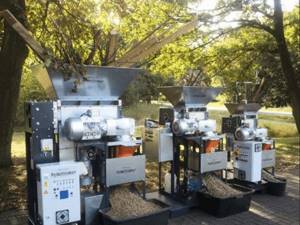
This is what pellet crushers look like
Additional drying and grinding stage
The moisture level of wood raw materials that are sent under the press should not exceed 10% with a deviation of 2% in one direction or another. If the resulting raw material is too wet, additional energy-intensive drying will be required. If parts of the wood used are too dry, they will need to be slightly moistened to achieve a 10 percent moisture level.

Pellet pellet dryer
Drying equipment is produced in drum and belt types. In this case, the last option is more preferable, although expensive. Using belt type pellet dryers is much safer. Dryers can run on gas or wood waste. There is also a division of equipment according to the type of drying unit used. It usually consists of hot air, water vapor or flue gases. Stable operation of a pellet press is possible only when the size of the input fraction of the raw material does not exceed the permissible 4 mm. Well-dried raw materials are re-grinded in special hammer mills, flakers, or disintegrators.
Water treatment of raw materials
If the moisture level of the raw material does not reach 8%, then it is very difficult to press. To obtain the required degree of humidity, you need to pass the dried raw materials through an additional humidification device. An excellent option are mixers on augers, into which hot steam or even water is supplied. Steam is usually used in the processing of wood raw materials, which are obtained from hardwoods. Under the influence of hot steam, the strength of the wood itself is greatly reduced and its ductility is significantly increased. The presses of some manufacturers are designed in such a way that they do not require preliminary exposure of raw materials to steam. Some not entirely conscientious manufacturers use steam to process raw materials that are too old and already caked. At the same time, it will not be possible to obtain high-quality pellets from raw materials “reanimated” in this way.
Pressing process
The granule formation process is carried out using special presses, which have design differences, mainly in the type of matrix. There are presses for pellets:
- With a round type of matrix, which were previously created for use in the food and chemical industries. They were also used for the production of animal feed.
- With a flat matrix type, created for solid waste disposal.
Despite significant design differences, both presses operate on the same principle. In them, running rollers crush the raw materials entering the matrix, ensuring its inevitable pressing through the holes provided for this purpose on its surface. The granules that appear from under the matrix are cut off with special sharp knives. During the entire pressing process, such equipment manages to compact the original raw material three times.

The process of forming fuel pellets using a matrix-type cylindrical press
Friction forces, which, under conditions of an adiabatic thermodynamic process caused by a very sharp compression of raw materials, contribute to a significant increase in temperature in the working compartment of the press up to 100 degrees. Therefore, to process a ton of raw materials, only 30-50 kW of electricity per hour is consumed. When pelletizing wood waste, the equipment experiences enormous constant loads, so it is made of especially durable materials. Some parts, like the matrix, are made from specially hardened wear-resistant alloys.
Cooling of finished pellets and cleaning them from contaminants
Pressure and temperature in the working area have a strong influence on the quality of the finished fuel. For this reason, the raw material should not be heated above 120 degrees, as this contributes to the onset of irreversible processes in its structure, which will greatly reduce all consumer characteristics of the fuel. Therefore, the already compressed granules need to be cooled. For this purpose, air conditioning equipment is used, which simultaneously blows dust from the granules.
Fuel pellet packaging and packing
Granular fuel can be packaged and packaged in a variety of ways. This allows us to largely satisfy the needs of all consumers. Pellets can be shipped in bulk, completely loose, or in very large bags, which are sometimes called “big bags” (holding from 500 to 1200 kg).
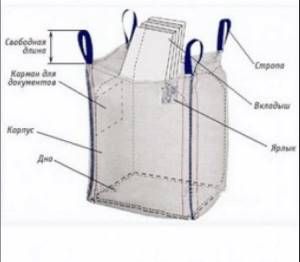
Diagram of elements of a polymer bag (big bag)
Fuel pellets are most often shipped in bulk and sent to large thermal power plants. Although it is also possible to ship bulk pellets with high quality. They are purchased for use in boilers of small enterprises or for further sale after packaging in small bags. “Big bags” are polymer bags that are equipped with durable slings to mechanize loading and unloading operations. Pellets that are stored and transported in bags do not lose their flowability at all and maintain the required level of humidity. Purchasing already packaged fuel pellets is naturally more expensive for the average consumer.
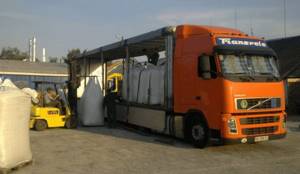
Specially equipped trailers for transporting big bags with granules
Big bags are transported on special vehicle platforms onto which they are loaded by forklifts. But bags of 10 - 20 kg are also popular, but with private owners of solid fuel boiler equipment. Owners of pellet boilers, as well as fireplaces, who do not have space for large supplies, purchase them in small packaging. This is how pellets of selected quality are sold.

Small packaging of the finest white pellets
How many pellets are needed for the heating season?
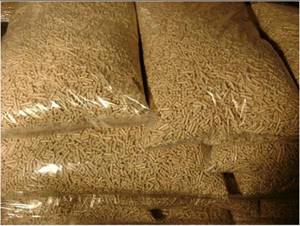
To calculate fuel consumption for the heating season, you need to know:
- boiler power (Pk);
- duration of the heating season (D).
Consumption = (Rk × D × 24 hours × 30 days × 0.7) / 3.5 kW/h.
The coefficient of 0.7 is included in the formula for a more accurate calculation, since the boiler will not operate at full capacity all the time. 3.5 kW/h – calorific value of 1 kg of pellets.
Let's consider an example calculation for a private house with an area of 200 m2, for heating which requires a 20 kW boiler, and the duration of the heating season is 6 months. Substituting these data into the formula above, we get:
Consumption = (20 × 6 × 24 × 30) / 3.5 = 17280 kg. It turns out that to provide heating for a house of 200 m2 for the winter, 17 tons of pellets will be required. At the time of writing (December 2021), one ton of pellets costs an average of 8.5 thousand rubles. This means that to purchase pellets for the entire heating season you will need 144,500 rubles. Draw your own conclusions. Is it worth purchasing this product or using a cheaper one - RUF briquettes.
What are pellets made of?
To produce pellets, they take waste that is supplied by wood production: dust, chips, sawdust, trimmings - any raw material containing lignin is suitable. In Russia, coniferous wood is most often used, although deciduous wood is significantly superior in quality. The use of needles is explained simply:
- for processing hardwood you need other, more complex and expensive equipment;
- Birch does not press very well.
But if you are lucky enough to find birch pellets on the market, it is better to prefer them. They release slightly more heat during combustion. In addition, when burning, birch fuel pellets do not form (unlike coniferous species) resins, which subsequently settle in the chimney pipe.
Pellet standards
Excellent granule quality is essential to achieve a constant and optimal heating process. Since there are different qualities of fuel, it is important for furnace and boiler owners to select the pellets that are best suited for their installations. Otherwise, an ill-considered choice may not only lead to loss of efficiency, but also disrupt the combustion process and/or complicate the maintenance of the device. This is especially important for small boilers and furnaces used in domestic environments, as the relevant tolerances are significantly lower than for larger boilers.
The standards for pellets for industrial stoves are not so strict, but it is still better not to experiment with cheap fuel. For the safety of others and equipment, it is important to distinguish between quality granules.
Ash content: Ash is the residue that is formed after complete combustion. The lower its content, the cleaner the pellet will burn, and the more efficiently the boiler will function. Low ash content reduces routine cleaning and maintenance.
Ash Melting Point: Ash having a low melting point will melt in the hottest parts of the combustion chamber and solidify. This solid residue, called “slag,” can create a number of problems, including affecting combustion, blocking equipment, and increasing maintenance costs.
Length, diameter and bulk density: Length and diameter are simple parameters, while bulk density should be explained as a measurement of weight per volume (kg/m3). Pellet length standards do not have a clear number; it can vary from 10 to 50 mm. It is better to use cylinders of approximately the same parameters so that there is no negative impact on the energy density. As for the diameter, it comes in two types, 6 mm or 8 mm. If the density is too high, the energy input of the boiler will be too high, causing the combustion chamber to overheat, while if the energy density is too low, the efficiency will be affected and may not generate enough heat to operate the system.
Dust: These are fine wood particles that can be found in bags and their low levels are an important factor as they directly affect storage, handling, maintenance, combustion efficiency and pollutant emissions.
Also read news on this topic
- Pellet production in Russia
- Pellets. Types of pellets
- Pellet storage
- Pellets for heating
Calorific value and humidity: For high-quality granules, the calorific value starts from 4200 kcal/kg and can reach 4500 kcal/kg. During manufacturing, the raw materials are dried to certain indicators and the lower the humidity level, the higher the thermal power.
Mechanical durability: Using this parameter, you can check the quality of the fuel without even burning it. The absence of cracks, crumbling and breaking into several parts when pressed indicates that the granules are resistant to pressure and destruction during transportation and in feeding screws, which allows maintaining a uniform consistency.
Nitrogen, Sulfur and Chlorine Content: These parameters, expressed as a percentage of total weight, will influence pollutant emissions and corrosion of heating appliances.
Heavy metals: Indicators expressed in mg/kg will affect emissions of harmful components during combustion and ash content.
Pellet standards for different types may vary. This is due to the fact that different raw materials are used in the production of granules. Chips, shavings, sawdust, stumps and other liquid remains of coniferous and deciduous trees are considered to be the highest quality raw materials. There is also granular fuel, which is produced from straw, husks, old furniture and other materials, respectively, their performance will be completely different.
produces and supplies fuel pellets from hard and soft wood. No chemicals are added during the manufacturing process, so the granules are safe and environmentally friendly. To see the effectiveness, get free samples to test. For any questions, call +7 or write by email
What caused such interest in this type of fuel?
Wood pellets are considered as the fuel of the future. Their calorific value is 4.3 - 4.5 kW/kg, which is one and a half times more than wood, but the heat transfer is comparable to coal. During combustion, emissions into the atmosphere are minimal. Burning 2 tons of fuel pellets produces the same amount of thermal energy as burning 957 m3 of gas, 1000 liters of diesel fuel, or 3.2 tons of wood.
It is no coincidence that pellets are called refined fuel - when they burn, a large amount of heat is released, and combustion proceeds in an even layer, as when burning traditional types of fuel. Fuel pellets do not require a significant amount of storage space.
Pellets are characterized by high energy concentration with insignificant volume. Their high bulk density makes it possible to transport fuel over long distances with high economic justification. Pellets as a biofuel are safe and reduce the risk of fires, explosions and leaks during transportation.
The consumption of pellets for heating a house with an area of 150 sq.m over a heating season of 7 months requires no more than 5 tons of pellets, and the combustion product is also used as fertilizer in the fields. The mass of ash is approximately 1% of the total mass of fuel pellets; it is removed in modern furnaces no more than once a year.
Application of pellets
Progress does not stand still and covers all new areas of human life. Despite the fact that pellets were invented in the middle of the last century, this type of fuel is only now becoming popular in Russia. Are they eco-friendly? How to store them and where to use them?
The fuel has the form of small oblong cylinders, no more than 50 mm long. Manufacturing features give it unique properties, and the use of pellets makes it easier to obtain energy and heat.
They have a high bulk density. This makes transportation and storage a simpler step than the transportation and storage of traditional resources. Production is gaining momentum every year and the finished products are packaged in convenient and sealed big bags or bags of various sizes. This makes loading and unloading faster and the pellets can be stored loose or in their original packaging.
As for environmental friendliness, we can say with confidence that they are safe for both humans and the environment. Wood waste is used for production, which would otherwise rot naturally, this allows us to be more careful with nature and use its resources without residue. During storage, they do not emit toxic substances, and the use of pellets eliminates the formation of toxic smoke during combustion.
Bags of granules can be stored in any dry place. They are non-flammable and do not pose a fire hazard. Fuels such as fuel oil, gas, diesel fuel and coal are easily combustible; in addition, they all emit harmful odors and, if used incorrectly, pollute the atmosphere. Therefore, they require careful handling during use. The new generation of fuel, pellets, is much safer for people who use them as a source of energy and heat. The most important thing is that the safety of a pellet boiler is much higher than the safety of similar gas or diesel equipment.
Also read news on this topic
- Pellet production in Russia
- Pellets. Types of pellets
- Pellet storage
- Pellets for heating
Existing stoves can be easily converted to use pellets. At the same time, they will be equipped with an automatic feeding mechanism, which eliminates the need to monitor the amount of raw materials in the furnace.
We invite you to evaluate all the benefits of using pellets, which are made from coniferous and soft wood grown in environmentally friendly regions. Once you try them and fully appreciate their benefits, you simply won’t want to go back to traditional fuels.
You can purchase pellets at a low cost directly from the manufacturer. You can get a free sample to test to ensure the quality. For any questions, call phone number: +7 or write by email
Basic parameters of pellets
Pellets for heating are granules of white or shades of brown, with a length from 10.00 to 30.00 mm, a diameter of 6.00 and 8.00 mm, less common fuel with a diameter of 10.00 mm, the maximum diameter of the granules is 25.00 mm. The darkening of pellets is associated with the presence in the structure of the material of various non-combustible residues (dust, earth, and a number of others).
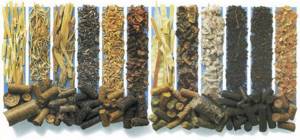
The main parameters of pellets are:
- ash content (the lower, the better and the less ash, so the boiler will have to be cleaned much less often);
- humidity;
- calorific value (ENPlus-A1 – 18.0 MJ/kg, ENPlus-A2 – 18.0 MJ/kg, EN-B – 15.0 MJ/kg).
- total length;
- degree of density;
- diameter;
- bulk mass;
- abrasion class.
Pellet production in Yekaterinburg
The production technology is based on the process of pressing crushed waste wood, straw, husks, etc.
- Raw materials (sawdust, straw, etc.) enter the crusher, where they are crushed into flour. The resulting mass enters the dryer, from which it goes into a granulator press, where wood flour is pressed into granules. Compression during pressing increases the temperature of the material, the lignin contained in the wood softens and glues the particles into dense cylinders.
- The production of one ton takes 3-5 m3 of wood waste with natural moisture. The finished granules are cooled and packaged in large big bags (several tons each) or small packages from several kilograms to several tens of kilograms.
- The production of fuel pellets is a process that does not stop all year round and does not depend on any unforeseen factors, since raw materials for this are constantly available. If you want to ensure efficient heating of a residential building (both private and multi-apartment buildings), industrial or warehouse premises, then wood pellets are one of the best options for this. Today, in European countries, this type of fuel accounts for 2/3 of all others used for heating various buildings. In Russia, the popularity of pellet fuel granules is constantly growing, as more and more consumers learn about their advantages.
Main stages of the production process
Pellet production can be roughly represented in the form of several stages:
- grinding of raw materials;
- drying of crushed components;
- regrinding of dried particles;
- water treatment for the purpose of moistening wood flour;
- pressing crushed and moistened raw materials into granules;
- cooling the pellets and cleaning them from dust;
- fuel pellet packaging and packing.
Let's look at each stage in more detail.
Stage #1 - grinding wood raw materials
Using chipping machines called crushers, wood raw materials are crushed into fractions whose length and width are 25 mm, and their thickness is 2 mm. Then the crushed raw materials are dried. The smaller the size of the fractions, the less energy required to dry them.
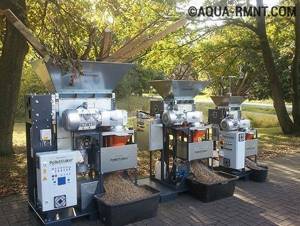
Using chipping machines called crushers, wood raw materials are crushed into fractions whose length and width are 25 mm
Stage #2 - drying and regrinding
There are specific requirements for the moisture level of wood raw materials sent to the press. The percentage of humidity should be 10% with a deviation of 2% down or up. If the raw material is too wet, additional drying will be required. If the wood fragments are too dry, they will have to be additionally moistened, achieving a 10 percent moisture level.
Drying equipment can be drum or belt type, with the latter option being preferable, although more expensive. Using belt type dryers is safer. Dryers can be operated on gas or wood waste. There is also a division of equipment according to the type of drying agent used, which can be water vapor, hot air or flue gases.
Stable operation of the press is possible only if the size of the input fraction of raw materials does not exceed 4 mm. The dried raw materials are additionally crushed in hammer mills, flake machines, and disintegrators.
Stage #3 - water treatment
Raw materials whose moisture level does not reach 8% are difficult to press. To obtain the desired degree of humidity, it is necessary to pass the overdried raw materials through an additional humidification device. The best option is considered to be screw mixers into which steam or water is supplied. Steam has to be used when processing wood raw materials obtained from hardwood. Under the influence of steam, the strength of wood decreases and its ductility increases.
Presses from a number of manufacturers are designed in such a way that they do not require preliminary steam exposure to raw materials. Some unscrupulous manufacturers use steam to process old and already caked raw materials. However, it will still not be possible to obtain good quality pellets from raw materials “revived” in this way.
Stage #4 - pressing
The granulation process is carried out using presses produced by world-famous manufacturers: CPM, Salmatec, Andritz, Amandus Kahl, Munch, Buhler, etc. This type of equipment has design differences, the main of which is the type of matrix. There are presses:
- with a round matrix (created for use in the food and chemical industries, as well as for the production of animal feed);
- with a flat matrix (created for solid waste disposal).
Despite the design differences, presses of both modifications operate on the same principle. Running rollers crush the raw materials on the matrix, ensuring its pressing through the provided holes on its surface. The squeezed out granules are cut off with special knives. During the pressing process, the equipment manages to compact the raw material three times.
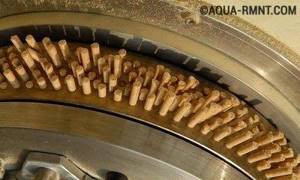
The process of forming pellets using a cylindrical matrix press. Granules of equal diameter are squeezed out through the holes of the matrix and cut off
Friction forces under conditions of an adiabatic process, caused by a sharp compression of raw materials, contribute to a rise in temperature in the working area of the press to 100 degrees Celsius. Processing a ton of raw materials consumes 30-50 kW of electricity per hour.
When pelletizing wood, the equipment experiences heavy loads, so it is made from especially durable materials. Individual matrix-type parts are made from hardened wear-resistant alloys.
Stage #5 - cooling the pellets and cleaning them from dust
The quality of the resulting pellets depends on the degree of effort applied to pressing the raw materials and the temperature at which the granules are formed. However, there is an upper “ceiling” of temperature values (120°C), above which irreversible processes begin to occur in the granulated raw material, negatively affecting the quality of the pellets.
Pressed granules require cooling, which has a conditioning effect on them. Equipment from well-known manufacturers is equipped with systems for cleaning finished granules from dust and small crumbs. Pellets are cleaned immediately after the cooling procedure. This has a positive effect on the quality of pellet fuel.
Stage #6 - packaging of fuel pellets and packaging
Granulated fuel is packaged and packaged in different ways, which allows you to satisfy the diverse needs of consumers. Pellets can be sold in loose form or in bulk bags - so-called “big bags”, containing from 500 to 1200 kg of granules.
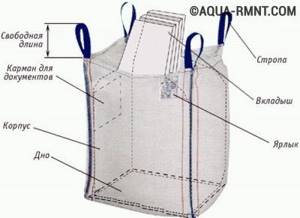
Components of a huge polymer bag (big bag) used for storing pellets in the manufacturer’s warehouses and subsequent transportation to the consumer’s bed
Fuel pellets are usually shipped in bulk and sent to thermal power plants. Although it is possible to ship in bulk high quality pellets, which are purchased for heating boilers, as well as for further sale in smaller packaging.
“Big bags” are polymer bags equipped with slings for mechanized loading and unloading operations. Pellets stored and transported in bags do not lose their free-flowing properties and maintain the required level of humidity. However, purchasing already packaged fuel pellets is usually more expensive for the average consumer.
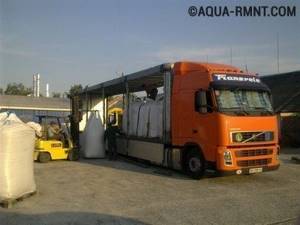
Special trailers for transporting big bags with pellets. Forklifts are used to unload heavy bags
Pellets, packaged in packages of 10-20 kg, are also popular among consumers. Owners of pellet boilers and fireplaces who do not have bins for storing large stocks of pellets buy them in small packages. Of course, this method of purchasing fuel pellets is considered the most expensive. However, only selected pellets are sold in small containers.
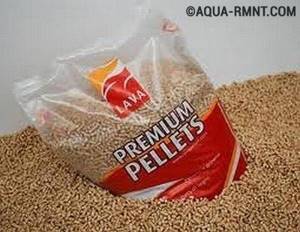
Many buyers find it more convenient to purchase selected pellets packaged in small plastic bags that can be easily transported in personal transport.
My help may come in handy
I professionally select equipment, modernize production, and can help with certification of pellets. I have a good quality book about pellet production, more details about it in the “MY BOOKS” section.

Good luck and see you again, Andrey Noak was with you!
People read this blog
3875
specialists in their field.
Read it too!
Pellet production
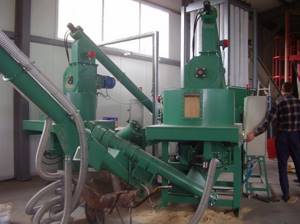
In order for the finished fuel to meet quality parameters, the raw material goes through several stages of processing:
- Splitting up. Grinding the waste helps to make the mass homogeneous, from which fine-grained granules no larger than 2x25x25 mm in size will then be made. This size is more convenient and dries faster.
- Drying. Residual humidity should be no more than 10%.
- Grinding. A hammer mill is used to crush the raw material into granules sized 4 mm.
- Hydration. To saturate the mass with moisture, a screw mixer is used.
- Pressing. The type of press used depends on the type of raw material. After pressing, the mass is passed through a sieve and then trimmed with a knife. The process is carried out at temperatures up to +100 C. An increase in temperature is unacceptable so that the pellets do not lose their combustible properties and burn well.
- Cooling down. Packing. These are the final stages of production, after which the fuel goes on sale.
Despite the lengthy processing process, the cost of pellets for heating remains low, which explains the popularity of the raw material.
How wood pellets are made from wood
For the production of pellets, the most inexpensive wood is taken, which cannot be used for any other purpose. These are scraps, wood chips, sawdust. This waste is sorted, cleaned of impurities, sand is sifted out, etc. Next, a powerful magnet used on the sorting belt attracts iron (such as nails). After removing foreign objects, the wood waste is sent to a hammer crusher, where it is crushed to 4 mm fragments. This stage is called pre-grinding. It is necessary for uniform drying of the raw materials at the next stage.
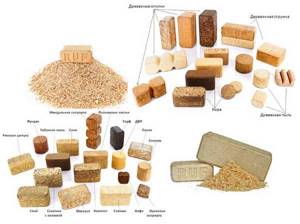
Pellets are also made from wood processing and agricultural waste
The resulting sawdust is dried in a special hopper to the required humidity (8–12%). After which they are sent for re-grinding. The result is small fragments of wood, which, after being brought to the ideal humidity (10%), are sent to a granulator press. Here, under pressure (in some presses, high temperature), sawdust is converted into pellets. To do this, the composition is passed through a matrix in which round holes are cut. The design of the granulator press resembles a regular meat grinder: the dough is pressed through the holes, and granules are obtained. They are cooled in the cooling column. This is how the final product is obtained - fuel pellets.
European and German pellet quality standards
| Pellet quality standards | Units | DIN Plus | EN plus-A1 | EB plus-A2 | EN-B | DIN 51731 | ONorm M 7135 |
| Pellet diameter | mm | 4-10 | 6(±1) | 6(±1) | 6(±1) | 4-10 | 4-10 |
| Pellet length | mm | ≤5хD | 3.15≤I≤40 | 3.15≤I≤40 | 3.15≤I≤40 | 5 x D1 | <50 |
| Bulk mass of pellets | kg/m3 | — | ≥600 | ≥600 | ≥600 | — | — |
| Heat of combustion of pellets | MJ/kg | ≥18 | ≥16,5 | ≥16,5 | ≥16,0 | ≥18 | 17,5-19,5 |
| Pellet moisture content | % | ≤10 | ≤10 | ≤12 | |||
| Abrasion/Dust | % | ≤ 1 | — | — | |||
| Pellet hardness | % | ≥ 97,7 | ≥ 97,5 | — | — | ||
| Ash content | % | ≤ 0,5 | ≤ 0,7 | ≤ 1,0 | ≤ 3,0 | — | — |
| Ash melting point | °C | — | ≥1200 | ≥1100 | ≥1100 | — | — |
| Chlorine | mg/kg | ≤ 0,02 | ≤ 0,02 | ≤ 0,03 | ≤ 0,03 | — | — |
| Sulfur | mg/kg | ≤ 0,04 | ≤ 0,05 | ≤ 0,05 | ≤ 0,05 | ≤ 0,04 | ≤ 0,08 |
| Nitrogen | mg/kg | ≤ 0,3 | ≤ 0,3 | ≤ 0,5 | ≤ 1,0 | ≤ 0,3 | ≤ 0,3 |
| Lead | mg/kg | — | ≤ 10 | ≤ 10 | ≤ 10 | — | — |
| Chromium | mg/kg | — | ≤ 10 | ≤ 10 | ≤ 10 | — | — |
| Arsenic | mg/kg | — | ≤ 1 | ≤ 1 | ≤ 1 | — | — |
| Cadmium | mg/kg | — | ≤ 10 | ≤ 10 | ≤ 10 | — | — |
| Mercury | mg/kg | — | ≤ 0,1 | ≤ 0,1 | ≤ 0,1 | — | — |
| Copper | mg/kg | — | ≤ 10 | ≤ 10 | ≤ 10 | — | — |
| Nickel | mg/kg | — | ≤ 10 | ≤ 10 | ≤ 10 | — | — |
| Zinc | mg/kg | — | ≤ 100 | ≤ 100 | ≤ 100 | — | — |
We have been producing and selling pellets for more than 5 years. Our pellets have high calorific value and low ash content, High quality, low prices!!!
Thank you for leaving a request, we will contact you shortly
Top
What standards are used to determine the quality of finished pellets?
All domestic pellet producers today use quality standards that are accepted in most European countries. Foreign manufacturers of solid fuel for pellet boilers must obtain certificates of conformity for their products in accordance with the quality standards in force in the European Union. If such a document is missing, then this circumstance scares away buyers. The EN plus and EN-B quality standards set out the requirements for both household and industrial pellets according to several criteria. These include: diameter, length, bulk density, calorific value, humidity, abrasion or dust percentage, hardness, ash content, ash melting point, content of metals and other chemical elements.
Production[edit | edit code]

Packaging of fuel pellets
In the USA at the beginning of 2008, more than 80 companies were engaged in the production of fuel pellets. They produce about 1.1 million tons of pellets per year. In 2008, about 2 million tons of pellets were sold in the United States[4]. More than 600 thousand buildings are heated with pellets. More than 20 companies produce boilers, furnaces, burners and other equipment for burning pellets.
In Finland, the household sector consumed 70 thousand tons of pellets in 2005. About 7 thousand buildings were heated with biofuel. “Road Map 2010” in Finland plans to produce 1.1 million tons of pellets by 2010.
In 2005, 582.5 thousand tons of granules were exported from Canada. In total, Canada produced about 1.3 million tons in 2008. Pellet factories are located mainly on the coast. Factories located on the west coast of Canada produce pellets from soft types of wood: spruce, pine. Factories on the east coast produce pellets from hard varieties: oak, maple, cherry, etc.
All pellets produced in North America are made from the dried residues of forest processing waste: sawdust, shavings, and wood chips. There are only two factories that add tree bark to the pellets.
The largest producers in the EU countries in 2008: Sweden - 1.7 million tons, Germany - 900 thousand tons, Austria - 800 thousand tons [4].
Latvia is actively developing biofuel production. In particular, in August 2012, the largest plant in the country was launched with a capacity of 175-200 thousand tons of pellets per year.[5]
Worldwide production of fuel pellets in 2008 amounted to 8-10 million tons[6].
In 2009, there were approximately 650 wood pellet plants in Europe, producing more than 10 million tons of pellet products.[7]
In 2011, approximately 15 million tons of pellets were produced in Europe.[8] At the end of 2013, global pellet consumption was about 22.5 million tons.[9]
Russia[edit | edit code]
In Russia in 2008, 500-600 thousand tons of pellets were produced, the production of fuel pellets was established at 150 enterprises in different regions of the country. [ source not specified 983 days
]
In 2009, about 960 thousand tons of fuel pellets were produced. About 260 thousand tons were used domestically[10].
In 2010, about 1 million tons of wood and husk pellets were produced in Russia. Most of them were exported to Europe. Moreover, while wood pellets are mainly purchased by Scandinavian countries, as well as central and northern Europe, Russian husk fuel pellets are purchased only by the UK and Poland.[11] Pellets produced in the Far East are exported to South Korea and Japan.
According to UN estimates, in Russia the annual production of fuel pellets in 2011 was 750 thousand tons, of which 600 thousand tons were exported.[12]
In 2011, Vyborg Cellulose OJSC (Sovetsky village, Leningrad region) launched the world's largest wood pellet production plant.[13] The enterprise's production volume should be 1 million tons of fuel pellets per year. In 2012, the company produced 500 thousand tons of granules.[14]
The Russian market of fuel granules (pellets) in 2015 showed a steady increase in production volumes and exports of products, increasing by 100,000 tons/year. This trend continues in the pellet market, despite a number of crisis phenomena in the economy. The majority of Russian companies involved in exporting products did not experience sales problems in 2015, despite the warm winter in Europe. This is due to the presence of long-term contracts with those manufacturers who have been operating on the market over the past few years. At the same time, due to the devaluation of the ruble relative to the euro, those companies that previously, from a logistics point of view, were not profitable to sell their products abroad, began to participate in the export of wood pellets in 2015. In the second half of 2015, 157 Russian pellet producers participated in the export of products. Domestic manufacturers are actively obtaining European EN plus and SPB certificates and entering new markets.[15].
Plans, forecasts, prospects[edit | edit code]
At the beginning of the summer of 2010, the University of Wageningen presented research in the field of biofuels. In the next 25 years, according to the study, the demand for wood pellets will increase in Europe to 200 million tons per year[16]. 13-20 million tons of pellets per year will pass through the port of Rotterdam. In July 2010, the Port of Rotterdam announced a joint project with the Anglo-Dutch energy exchange APX-ENDEX[16] to create a biofuel exchange.
By 2021, China aims to produce 50 million tons of pellets annually.
The UK planned to increase consumption of fuel pellets to 600 thousand tons by 2010. In 2014, Austrian pellet production is expected to reach more than a million tons, and the country's government plans to double pellet consumption by 2020.[9]
In 2010, the Russian Forest Pellets holding announced plans to build production facilities for wood pellets in 13 regions of Russia with a total capacity of more than 2.5 million tons of pellets[17].
In 2012, LLC “Group” announced a program for the construction of 52 plants in Russia with a total capacity of up to 10 million tons of fuel pellets per year, in particular, the company plans to build 9 torrefied pellet plants in the Moscow region.[18]
At the beginning of 2021, the largest German pellet manufacturer, German Pellets, declared bankruptcy. In 2014, the German company created a Russian subsidiary, German Pellets Nizhny Novgorod, and announced the construction of a pellet plant in the Nizhny Novgorod region with a capacity of 500,000 t/year, but the plans were not implemented.[19]
Measuring the moisture content of fuel pellets in a stream
Selecting SONO series moisture meters
SONO-HC family of moisture meters
SONO family of moisture meters
SONO-LD family of moisture meters
Moisture meter SONO-MIX
Moisture meter TRIME-GW
Fuel pellets are a type of biofuel in the form of standard-sized cylindrical granules obtained from peat, wood waste and agricultural waste.
The moisture level of pellets produced from wood material is critical to achieving end product quality goals. Wood pellets that are too wet can result in incomplete combustion, resulting in inconsistent heating. In addition, stored pellets with high moisture content can cause microbiological activity, which can lead to spontaneous combustion in silos. Over-dried fuel pellets are also vulnerable because they become brittle, compromising the integrity and quality of the finished product. Uncontrolled drying leads to increased energy consumption.
Granules burn well if their humidity is not higher than 12%. Checking the moisture content of raw materials at different stages of production allows you to correctly organize the entire production cycle, as well as monitor the operation and malfunctions of each unit of the pellet line.
To measure and control the moisture content of pellets, an in-line biomass moisture meter with particularly precise measurements is required.
The innovative TRIME TDR technology allows accurate continuous measurements directly during the drying process at temperatures up to 140°C and regardless of the type and composition of the product being dried.
IMKO has developed an in-line bulk solids moisture meter SONO-VARIO LD, designed for highly accurate measurement of the moisture content of fuel pellets (wood pellets).
| Material | Controlled parameter | Specifications | Measurement location | Purpose of Humidity Control | Solution |
| Fuel pellets | Humidity | Temperature up to 140°C Humidity measurement range 0-50% | Conveyor Auger Hopper Dryer | Humidity before drying 15-50% Humidity after drying 3-8% | In-line moisture meter for bulk materials SONO-VARIO LD |
The main advantages of the SONO-VARIO LD moisture meter:
- precise measurements thanks to innovative TRIME TDR measurement technology;
- reliable sensor measuring head made of stainless steel;
- up to 15 calibration curves for various materials in the sensor memory;
- integrated signal processing, standardized 4-20 mA output comes directly from the probe;
- indicating processing module (connection of up to 4 sensors).
Standard equipment of the SONO-VARIO LD moisture meter:
- mounting flange;
- sensor SONO-VARIO LD (max. temperature 70°C, output signal 4-20 mA, RS 485, power supply 24 V);
- cable 10 m;
- USB converter for on-site calibration of the moisture meter;
- software.
Comparison of pellets with other types of fuel
| Type of fuel | Heat of combustion (MJ/kg) | Calorie content (kcal) | % ash | % sulfur |
| Coal | 15-25 | 4500-5200 | 10-35 | 1-3 |
| Brown coal | 14-22 | 4000-4300 | 10-35 | 1-3 |
| Firewood | 10 | 2000 | 2 | 0 |
| Peat pellets | 18,0 | 4500-4800 | 6 | 0,7 |
| Wood pellets | 18,4 | 4800-5000 | 2,5 | 0,1 |
| Peat briquettes | 14,9 | 3200 | 23 | 1-3 |
| Natural gas | 35-38 MJ/m3 | – | 0 | 0 |
User reviews
You can find various forums on the Internet that present both positive and negative aspects of using pellets.
Here are a few for comparison:
- Sergey. The draconian payment bills constantly cost me huge amounts. After they brought us a bill for the first heating month of October with an amount of 15 thousand, my wife decided not to tempt fate and switch to pellet heating. We purchased a KST-25 boiler with a 14/40 kW burner. Of course, now you spend less on heating, but there are problems with purchasing. We have to constantly purchase large quantities, for which we had to organize a separate warehouse in the basement.
- Alexander. I own my own beauty salon. Deciding to get off the “gas needle” (you had to pay 10 thousand to heat a small room), I chose pellet heating. Having tried several types, I settled on an alternative option, sunflower husk granules, I pay 1.5 thousand rubles for one ton. Some simple calculations gave me an amount of 14 thousand, which was enough for heating from October to April. Quite acceptable.
Considering that we are increasingly trying to imitate Europe, this heating option will soon become one of the popular ones. In our market, the production of pellets and the sale of boilers have not yet been fully established, so there is a good option for organizing your own business, as well as big advantages in favor of switching to this alternative heating method.

